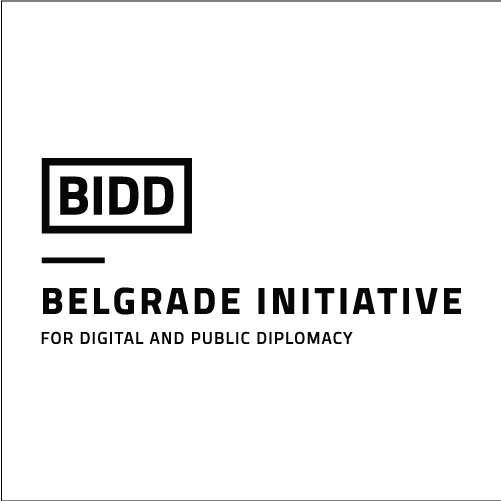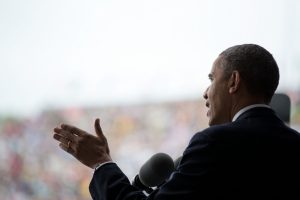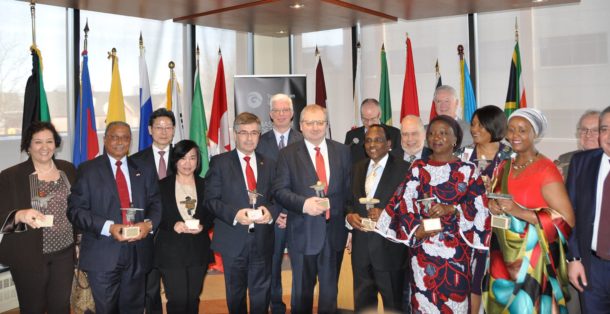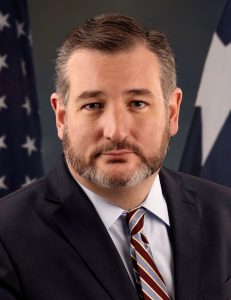canadacouncil.ca; see also (1) image (not from entry) from
image (not from entry) from
Speech by Simon BraultCercle France-Amériques, Paris
October 16, 2018
Canada: Diverse and equal voices
In both the Americas and France, much has been written and said about the ways governments can use cultural diplomacy as a tool of foreign policy. Governments might, for example, share scientific, academic, literary and artistic research, ideas and creations, and exchange comparative perspectives on a variety of topics within the cultural field. They pursue these kinds of activities in a bid to have a positive influence, initiate a dialogue with the potential to move beyond the realm of ideas and culture, and to maintain ties that could soften economic or political disagreements, if not military conflicts.
Of course, countries—and especially governments—vary in their approach. These differences are marked by the size of their budgets, the specific tools they implement, their public diplomacy [JB emphasis] directives and, increasingly, the complex frameworks they employ to bridge the public sector, private sector, and civil society.
Defining cultural diplomacy
Cultural diplomacy changes, adapts, expands and contracts in response to shifting political regimes and situational requirements. Fortunately it never goes away altogether. That’s because it is based on long-standing traditions, and because culture will always be there to come to the rescue when humanity is under threat. That said, there continue to be debates about the relative importance and usefulness of cultural diplomacy, which are coloured by the issue of assessing its tangible effects. It is undoubtedly easier to compile data on our commercial exports than to measure the flow of ideas and values and assess their impact on furthering the understanding between peoples and the prevention of conflicts of all kinds, including terrorism.
I certainly cannot claim to know the future of cultural diplomacy. Instead, I propose that tonight we take a look at a significant part of Canada’s engagement with cultural diplomacy— mainly with France, but also with the world at large. I base my presentation on the observations I am able to make as the Director and CEO of the Canada Council for the Arts.
I will mainly address how artistic creation can potentially contribute to initiatives in cultural diplomacy and, in particular, to the human interactions that inform exchanges of every nature and scope between peoples, nations and countries.
First, I would like to say a few words about Canada’s system of support for the arts.
Overview of Canada’s system of support for the arts
Government
Canada has three levels of government: municipal, provincial or territorial, and federal. Each has different powers as determined by constitutional law, and some areas of jurisdiction are shared. Arts and culture fall under the purview of all levels of government. Sometimes, several entities within a single level of government, such as the federal government, are required to collaborate. As such, the Council often works with the federal departments of Canadian Heritage and Global Affairs on the international aspects of arts and culture.
Even though many entities are involved, the right hand usually knows what the left hand is doing. They must keep one another in the loop.
Collaboration within Canada and social cohesion
Canada is a vast country with two official languages, 600 First Nations and more than 200 ethnicities. This rich diversity cannot be reduced to confined systems of expression and creation. There is a collective willingness among governments and institutions across the country to act in ways that complement one another, and to share knowledge that enables us to more readily respond to social change and better represent all Canadians.
This is where the principle of equity comes in: culture must contribute to an inclusive form of development. Social cohesion is at once a concern and a backdrop against which to create, and increasingly something to which we aspire.
Social issues: Indigenous peoples and equity
The major issues that currently define the trajectory of our country must be taken into account when creating and sharing arts and culture. For example, the process of truth and reconciliation between Indigenous and non-Indigenous peoples in the country is a major focal point. Historically, past governments have derided Indigenous peoples in Canada for speaking their truth. We must listen to them. To do this, we must create spaces for Indigenous peoples, and especially their artists, to speak their truth in their own way.
We must recognize the urgent need to redefine the relationship between Indigenous and non-Indigenous peoples in many countries, including Canada. We must also recognize the hopes of today’s young people, and social movements like #MeToo, Black Lives Matter, and the Occupy movement—all of which highlight to us how we’re stuck in unjust, oppressive and archaic systems.
The Council’s current financial position
These are the basics of what has led the Canada Council for the Arts, which I have the great pleasure and responsibility of leading, to make a fundamental change in the way it supports the arts. We’ve committed to increased support to artists, a strong international strategy, an Indigenous-led granting program specifically for Indigenous artists, and support for the digital shift.
Of course, the decision by Justin Trudeau’s government to double our budget over five years (between 2016 and 2021)—a globally unmatched government investment—gives us the means to implement our vision.
The Council’s current structure
To achieve our vision, we’ve had to reinvent ourselves. This has meant re-envisioning all of our programs, rethinking our structure, reframing our internal culture and repositioning the Council within the public sphere. We must also continue to appeal to artists’ and cultural administrators’ sense of individual and civic responsibility. We cannot allow the idea of protected territories and impregnable borders to be a barrier. That’s because the engagement of each member of the arts community and of the wider public will influence how our society’s culture advances.
The commitment that artists and cultural administrators have to artistic creation and culture will give them an important seat at the table in the major discussions about our society’s progress and international presence.
State of affairs: On not becoming tourists in the ruins of our past
Historical overview of current funding systems: Worldwide
Even if the idea of supporting artistic excellence sounds straightforward, it will take serious work to reform our systems to be truly inclusive, participatory and socially transformative. Since the Second World War, we’ve been clinging, for better or for worse, to basic assumptions about freedom of expression, peace and prosperity that have gradually become the foundation on which the benefits and privileges afforded to a minority of today’s population have been built.
The assumption of postwar democracy was that it was enough to consistently sustain an abundance of professionally produced arts and culture, approved by experts based on universal criteria for excellence so that as many people as possible could enjoy their uplifting power. This assumption is regularly disproved by cultural statistics confirming the audiences we took for granted are shrinking, and the audiences we want to tap into, particularly digital natives, are becoming increasingly indifferent.
We based our cultural policies and organizational structure on the strategy of programming. We thought vertically: we imposed our choices on potential consumers of culture through argument, or sold them through unidirectional communication.
Historical overview of current funding systems: Canada
In Canada, we created these systems 70 years ago out of sheer, dire necessity. Arts production and development grew out of this, and important arts institutions and organizations were created. Today, arts and culture are being held back from further advancement by silo mentalities and strategies based on the premise of infinite growth.
We have some clear issues to grapple with: the type of art favored by government funding still suffers from anemic attendance levels, while the breakneck growth of online content is causing an explosion in cultural preferences. On top of that is an increasing desire for active participation and involvement in the actual creation processes, which calls into question our closed systems in which knowledge and expertise control the presentation of content. The desire for direct involvement is heightened by our digital engagement. We see our contemporaries refuse to be treated like mere spectators, passive and receptive customers or even consumers. In the cultural sphere and elsewhere, people are seeking quality relationships rather than the pressure to close a deal.
Growth as a mindset and operating model
As I alluded to before, we are justifiably proud to have consciously incorporated major humanistic principles into our operating, decision-making and management models over the decades. But we have to acknowledge that we instinctively take a top-down approach to planning and communicating most of the time, while any exercise in reinvention based on cultural democracy requires the quick, ongoing back-and-forth of a bottom-up approach.
This means we must recognize that, in the age of instant sharing and making friends with a single click, hierarchies and authority—perhaps even expertise—are being disrupted. Most urgently of note is the end of the hegemony of growth at any cost. To be clear, I am not sounding the death knell for growth; I am simply saying that it is becoming less relevant to our decision-making for the future.
The institutions we have now were developed during a time in history when the standard of living for Canadians doubled twice. The idea of robust, steady growth had us riding high. Now we have to face a brutal comedown. Confining ourselves to cultural, economic and organizational models that may have served us well in the past is a simple indulgence in nostalgia, if not an appeal to protectionist and isolationist interests.
A call to change as the premise of growth
We must not, and we cannot, build our future on nostalgia.
In Canada, our past has precolonial, colonial and postcolonial connotations. And we share some of these afflictions with Europe. But our present and future will undoubtedly be different if we do away entirely with the idea of borders, accept multiple citizenships, and actively and consistently uphold universal human rights.
We also need to strive to better understand the impact of the continuing disruption to the cultural models of distribution, consumption and attendance that we still take for granted.
In May 2018, we brought cultural leaders and thinkers, arts funding representatives and artists together for the Americas Cultural Summit.
At the Summit, I launched a call to action with the participants. It is a call to be more ambitious in our relationship with one another.
A call to work together to make the arts and culture pillars of development in our societies. A call to rethink cultural citizenship, beyond excessive economic, geopolitical, organizational, political, national or even digital demands.
And today, I am reiterating this call for action.
State of the future: State of emergency
State of current cultural systems
I am reiterating it so we can work together, in solidarity, as players in a future from which we will gradually be shunned if we do not demonstrate solidarity.
Solidarity in building, not by discounting different perspectives, but by capitalizing on the major areas of consensus that transcend our respective circumstances, practices, environments, organizational scales and boundaries.
We are living in a critical time. Entire systems and sectors are imploding because the assumptions they were built on no longer exist. Traditional boundaries and markers—like those of nations and artistic, scientific or other disciplines—are disappearing.
Intermediaries such as broadcasters, distributors and mediators are at risk of being replaced by platforms whose algorithms make some content virtually invisible and significantly undermine the diversity of content.
Intermediaries such as broadcasters, distributors and mediators are at risk of being replaced by platforms whose algorithms make some content virtually invisible and significantly undermine the diversity of content.
Reforming systems and the digital challenge
The complexity of reforming systems based on cultural democracy stems in part from aspects of our dematerialized, hazy world, in which we are ever more immersed in our digital age. It is a world in which hyper-communication confuses information with misinformation by making it an instantly intrusive presence at all times—to the point where it becomes a universal reality, paradoxically shared in a fragmented, disembodied, abstract and inconsistent manner. We are trying to keep afloat in a world where volatile opinions sometimes lend themselves to the conclusion that democracy falls back more than it moves forward.
We have to admit that this age of over-communication and over-socialization encourages consumption over participation. Algorithms set the parameters for consumption and confine us to communities of “sameness” instead of promoting social conscience, openness toward others and true human solidarity. As Jean-François Fogel and Bruno Patio write in La condition numérique: “A world built on what we already know is a world that has nothing to teach us.” They also say: “Likely, a search engine’s ultimate goal is to suggest questions before people even know they want to ask them.”
I am certainly not denying that digital platforms are wonderful communication, information and sharing tools. Indeed, I myself am a shameless tweeter who uses this tool to both obtain and dispense information on a daily basis—a tool which will also become obsolete one day.
But despite these platforms, we are struggling to find new ways to discuss, think and challenge ourselves. We need new ways to rethink our collective experience, counter the dismantling of democratic values, and redefine human development. Compassion and humanism, which bring us together and provide us comfort and food for thought when we are faced with viral news of a world-scale tragedy, could at any moment be crushed by other phenomena that are just as viral, but that are suffused with fear, intolerance and folly.
Cultural democracy, soft power and shared leadership
Proposal for new parameters for the digital world: Art and culture
How should we set parameters for discussion that demonstrate openness and keep us from getting lost in this sea of digital content, information and misinformation? We need to know how to leverage culture to move, rally and inspire others in a globalized world. Imagine that your country’s artistic creations arise from the vitality of your cultural democracy. Do artistic creations not become the ultimate way to establish dialogues between cultures? Are these dialogues between cultures not what will help us break out of the limits set by our borders and our current systems?
In his article “The Information Revolution and Soft Power,” Joseph S. Nye, American political scientist from Harvard, says:
One of the notable trends of the past century that is likely to continue to strongly influence global politics in this century is the current information revolution. And with it comes an increase in the role of soft power – the ability to obtain preferred outcomes by attraction and persuasion rather than coercion and payment.
This remark is particularly interesting. The position of power that technological innovations hold is often fleeting. Arts and culture, however, draw from our accumulated human experience to portray our progress. They leave behind a legacy for future generations more vital than all material wealth. Arts and culture are our greatest natural resources, and they can never be depleted. We have to mould them into the pillars of sustainable development. Through them, we come into contact with, and understand, one another. Arts, culture and heritage reflect the ever-shifting, diverse, unprogrammed essence of who we are.
Today’s artistic creation—and even past creation that has carved its place in our heritage and culture—creates the spaces needed to build lasting human, diplomatic, commercial and sociopolitical relationships.
Freedom of expression, democracy and soft power
It’s also what reinforces our work to support the arts and artists on the international stage. Artists are not—and must not feel obligated to be—ambassadors in the political sense—but they are voices. And although their voices can often be conflicting and critical of our reality, artists express concerns that politicians might not dare to raise, concerns that speak to people both in their own country and beyond its borders. This freedom of expression is the guardian of democracy and of its renewal.
The complexity and uniqueness of artistic and literary works invite the viewer to interpret, reflect, and explore the other, all with an open mind. Art provides a forum for genuine, human discussion, where predetermined roles cease to exist. Art forces us to re-evaluate our relationship with an object or idea whose meaning or scope is never static.
Soft power should be approached with caution and respect. It must not become another currency or a new allegory that promotes uneven transactions. Of course, soft power is associated with an economic and political dimension, but it should not be reduced to a short-term objective: it has to be developed in a spirit of true cultural diplomacy. Again, we have to acknowledge the arts’ ability to bring people together, and see the arts as a rich, grammarless language we can use to speak to, listen to and better understand each other.
A language to renew cultural diplomacy, which we desperately need in a society and world riddled with polemics, identity-based conflict and social isolation.
We need the arts’ ability to reinvent itself. We can no longer stand by, horrified and helpless, and watch humanitarian crisis after crisis, each one worse than the last. We need to develop a model of digital civilization to steer clear of our own fate.
We must harness the arts’ power of reinvention to renew cultural diplomacy and foster relationships that make it possible for peoples and nations to work together and perhaps even build a shared road forward.
Thank you!
Original Article







